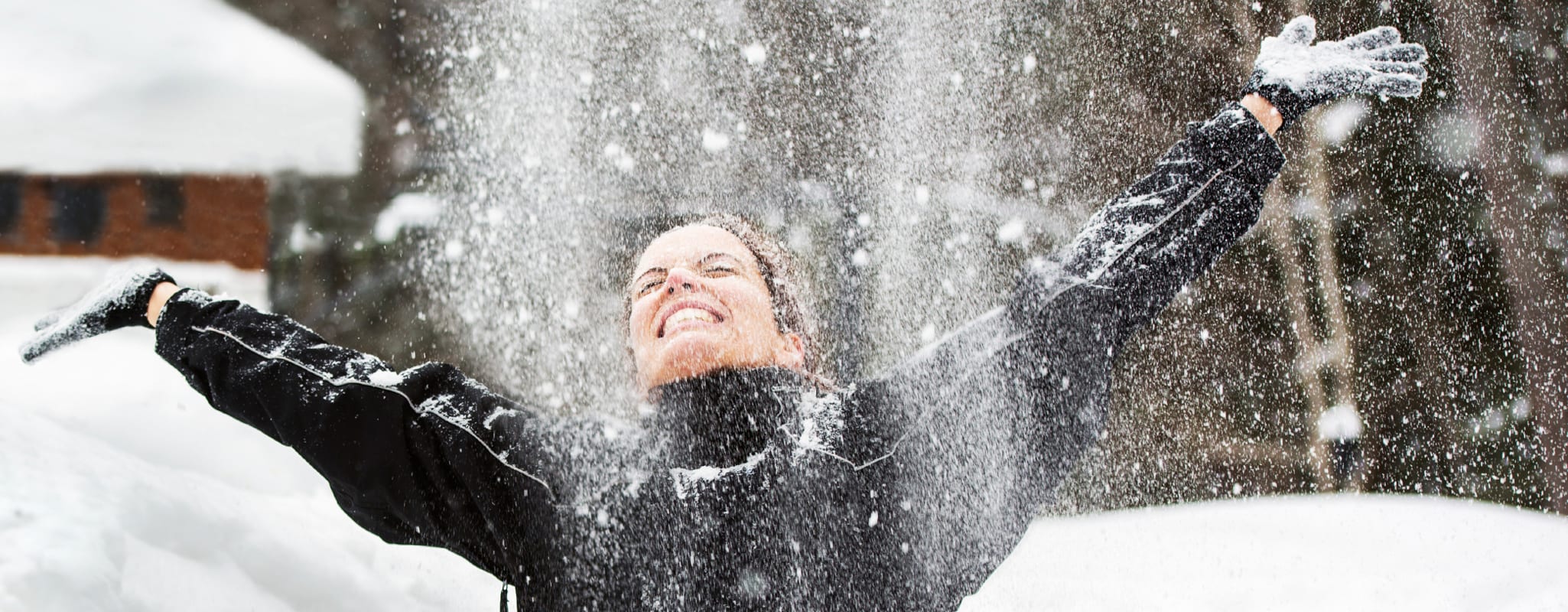The Snow-Day Workout


A chilly morning can make waking up for an early gym session seem particularly torturous. Foul weather can also make it tough for outdoor exercisers to keep up their routine. (Ever try to jog on ice? We don’t recommend it.) Many of us might as well pack our exercise clothes (and for that matter, skinny jeans) away with our summer gear.
But winter weather needn’t throw us into hibernation mode. Remember what it felt like to wake up on a snow day? Overjoyed at the prospect of a day without school, we jumped into snowsuits and wouldn’t come back inside for hours. Although we didn’t realize it at the time, playing in the snow is an excellent full body workout. In fact, when you get active in snow, cold weather naturally boosts the energy you expend: “Your body is going to work harder at staying warm — therefore burning more calories,” explains celebrity trainer and author Kathy Kaehler.
|
Top safety tips |
|
Whether you’re with your kids or solo, be smart in the snow.
|
Another bonus: You may work out longer since you won’t feel that “I’m so hot, I can’t go on” feeling that you do in warmer weather. And the cold stuff can act like frosty weights, increasing resistance. According to Bill McArdle, an exercise physiologist and Scientific Advisor to Weight Watchers International, “Walking in packed snow increases by 60 percent the calories burned compared to walking on a paved road, while walking in soft snow triples the calories burned compared to walking at the same speed on a treadmill. In addition, the added resistance of the snow can firm and tone the muscles."
The best part? You’ll have plenty of workout partners when your little ones (whether they be children, grandchildren, or neighbourhood visitors) have a snow day. And not only will having company help motivate you (and negate the need to hire a sitter while you’re at the gym), you’ll be teaching them that there’s more to entertainment than technology. “Exercising in the outdoors with your children establishes positive behavioral attitudes that, in the long run, will aid in countering the epidemic of childhood obesity, type 2 diabetes, and the myriad other diseases related to both obesity and a sedentary lifestyle,” says McArdle.
Luckily, he adds, many of our favourite winter activities count as workouts, including snow shoeing, ice skating, snow shoveling, cross country skiing or just rolling around having freezy fun. “A person of average fitness who performs any of these “big muscle” physical activities for a 30-minute period at a rating of perceived exertion of “somewhat hard” would burn between 200 and 300 calories per exercise session,” says McArdle. Looking for a more structured program? Try the 30 minute workout below, designed by Kathy Kaehler. And for those lucky enough to live in climes that never see snow? Next time you take a ski vacation, try out these moves before hitting the schnapps!
|
The 30-minute Winter Wonderland Workout Developed by Kathy Kaehler for Weight Watchers | |
| This 30-minute workout consists of 7 moves, each a 10 minute cycle. Do each cycle three times, with the first as a warm-up at low intensity (you should be easily able to carry on a conversation), the second at moderate intensity (you should be able to carry on a conversation, but feel that you’re working) and the third one at high intensity (pushing yourself as hard as hard as you feel comfortable). | |
|
1 |
Military march Trainer tip: Focus on swinging your arms and lifting your knees high to maximize lower body toning and calorie burn. |
|
2 |
Plank walk Trainer tip: This is great for chest, shoulder, triceps and core. To make it tougher, gradually increase the amount of time you hold your body in the pushup position. |
|
3 |
Snow shuffle Trainer tip: Keep your body low and move quickly to blast calories and tone both the inner and outer thigh. |
|
4 |
Frozen lawn lunges Trainer tip: Keep a tight belly to work your core as well as your lower body. |
|
5 |
Snow ball target practice Trainer tip: This exercise is great for the lower body, butt and legs as well as the chest and shoulders. |
|
6 |
Feet drag Trainer tip: Make sure not to cheat by speeding through the drag. |
|
7 |
Angel abs Trainer tip: During your snow angels, keep your arms and legs straight and extend them as far as possible to maximize the resistance. |
| 8 | Stand up, take a deep breath and begin cycle again. |